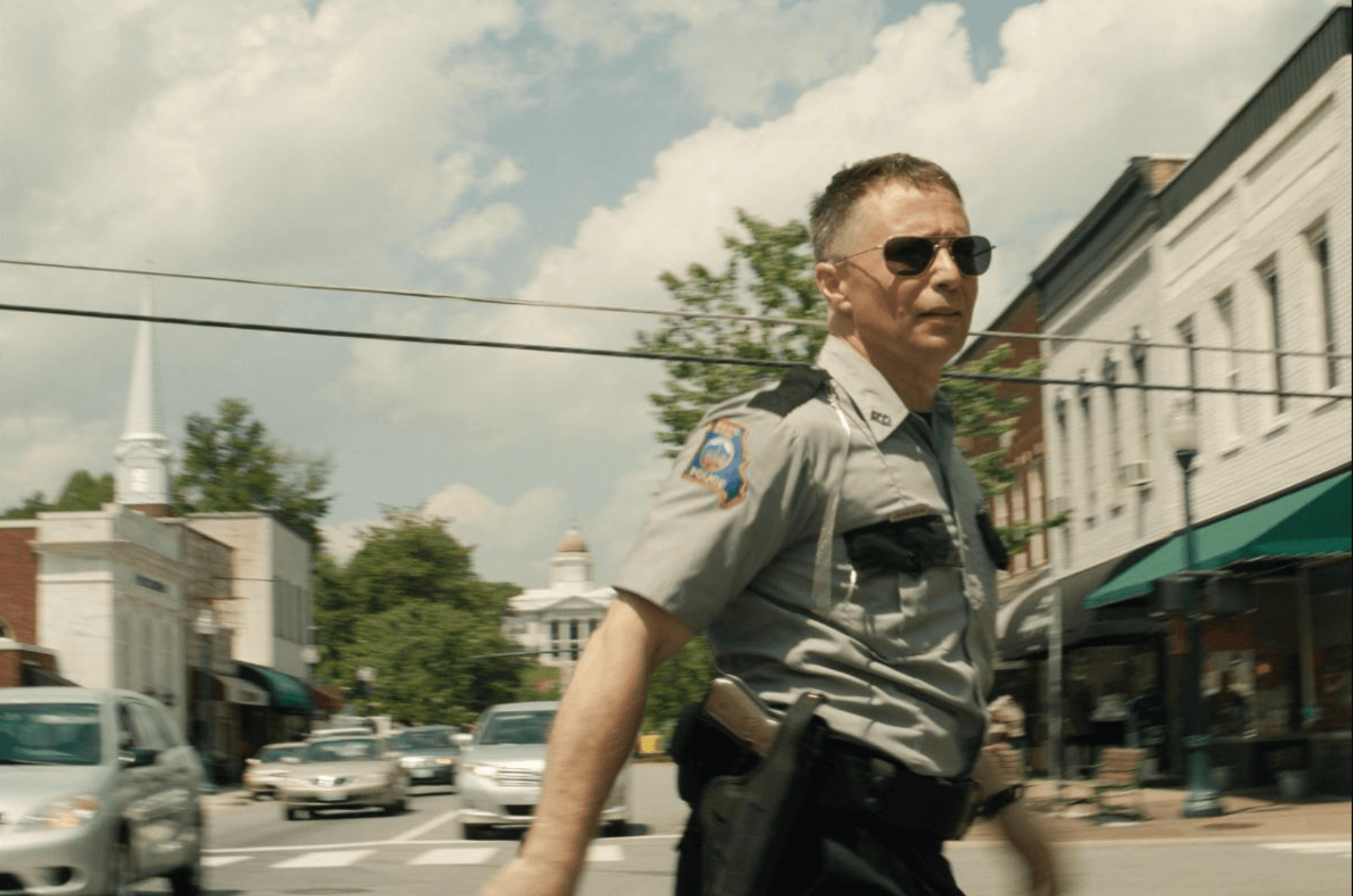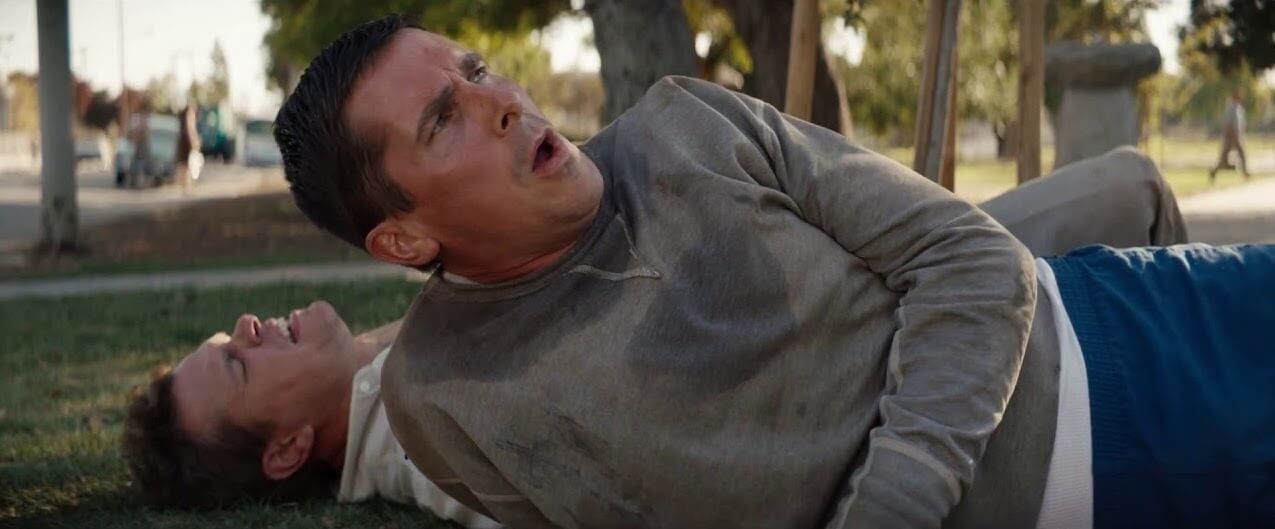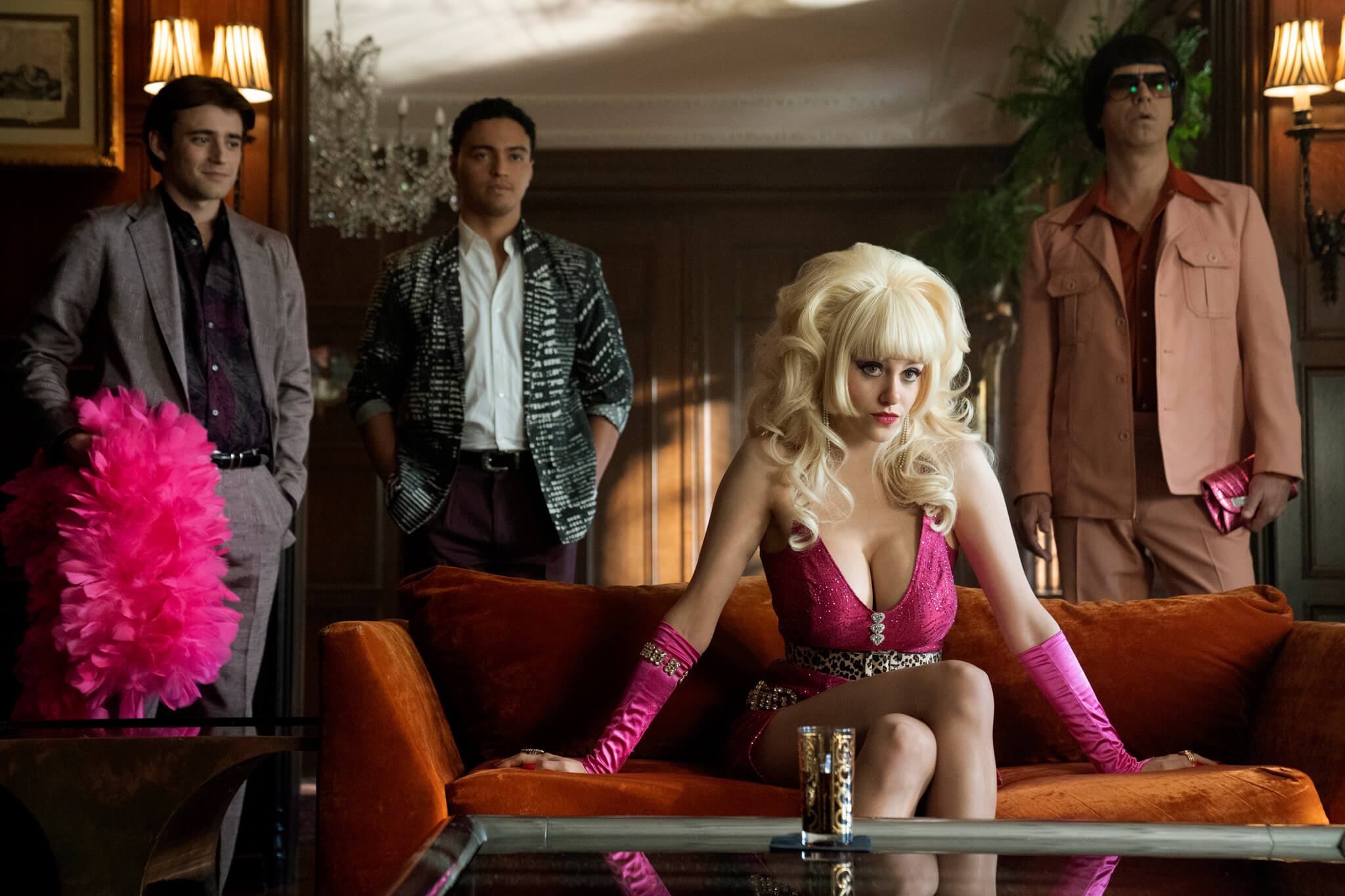Location Manager Robert Foulkes is no stranger to Hollywood. In fact you can say he’s on intimate terms with Hollywood royalty. As a five-year-old child actor, he kissed Bob Newhart on the cheek during an episode of The Bob Newhart Show. Growing up in Los Angeles, the business has always been a part of his identity. However, by the time Foulkes reached thirteen, his interest in acting faded and his love of storytelling evolved. After attending film school and working on a variety of passion projects, he found an opportunity in location management and never looked back.
His impressive resume includes the high-octane world of racing in Ford v Ferrari, the glitter, glamor and underbelly of Hollywood in La La Land and the legendary, retro vision of the studio system in the anthology series, Feud: Bette & Joan.
 Robert Foulkes in the production office of La La Land
Robert Foulkes in the production office of La La Land
Assemble was fortunate to sit down with Robert for a masterclass on all things location. He tells us the trials and tribulations of securing, maintaining and finding locations for a film and the joy of putting it all together.
Over the course of his career, Robert has worked on many outstanding films, so we asked him to describe the most iconic, challenging and important locations that were featured in five favorite projects.
Three Billboards Outside Ebbing, Missouri
Assemble: The police station / advertising office scene is an intense one, dramatically and technically. The long, single take required starting in one location, crossing the street, entering another building, following Sam Rockwall up the stairs, engaging in violence with two characters and then retracing his steps. You had to find the town and the structures that would allow the geography of the shot. Can you take us through the process and the decisions that were made along the way in discussions with the producers, director and crew?
Robert: Sometimes one particular scene in a script presents itself as the anchor that will drive the initial scouting process. In other words, locking down the favorite for that scene can then help decide where the entire production will be situated, with all the other script’s locations hopefully then branching out from that production office. In this case, the main street in Sylva, North Carolina became that anchor. From the moment I saw how well it could work in the way that Director Martin McDonagh had written it, I had a hunch Sylva would be the one.

Martin envisioned this scene as a single take, but a few visual and logistical elements needed to work in order to fulfill that vision. I needed a small town police station (or rather, a large storefront that could be dressed as one) situated along a visually interesting main street, and also have it be across the street from another similar scale building that could play as a 2nd floor advertising office. What helped make the two buildings in Sylva ideal was that the stairwell up to the 2nd floor access actually faced the police station. The vast majority of other small town buildings scouted throughout North Carolina had stairwells but they were too often situated on the side of the building or the main street itself felt too down or too gentrified. Here, we not only had the perfect route for Sam Rockwell to walk but a great looking street as well (heck it even had a picturesque courthouse at one end!).

Location Scouting Template
Use our location scouting template and checklist to ensure that you cover all of the most important location related information for your film shoot.
Get Template
Once you fall in love with the perfect location, next comes the work of making sure a production can actually film the movie there! In the case of Sylva, that entailed convincing the town’s powers-that-be that we could essentially take over a large section of their main street for more than a month, detour its traffic, get several building owners and tenants on board with all the cosmetic changes required, and, in the case of the police station, completely emptying it of all its furnishings and line the entirety of its walls and ceilings with a fireproof material so we could ultimately “burn it down” with Frances McDormand’s Molotov cocktails!
Martin so wanted to make sure my initial meeting before the town council members went well that he joined in to help personally present our case (that safety will be of utmost concern, and that it can be good for business in the community). We then stood outside with fingers crossed while they deliberated, and what a great feeling when they brought us back in to announce their pro-filming verdict and formally welcome us to their town!
Ford V Ferrari
Assemble: Ford v Ferrari is centered around Carroll Shelby and Ken Miles, who battle corporate interference and physics to build the Ford race car that defeated Ferrari at the 24 Hours of Le Mans in 1966. The racing scenes were a thrilling part of the production and I assume challenging. I know that Director James Mangold and Cinematographer Phedon Papamichael were interested in a film-like aesthetic that mirrored how it would actually look in the 60’s and 70’s when the film took place. However, although there is plenty of action, the film is as much a character driven picture exploring the volatile relationship between these two men. One such scene that explores their dynamic is a physical fight outside of Miles’ home witnessed by neighbors and Miles’ wife. What can you tell us about the logistics of making that scene work?
Robert: The scouting, securing and shooting of our numerous race track scenes was very rewarding, but often even a mere dialogue-driven location can also have that effect on a Location Manager. That was the case with the Ken Miles House / Auto Repair Shop combo. Director James Mangold wanted these two-for-one locations to be situated in a very specific way, that they not be right next door to each other, nor even directly across the street, but in a catty-corner angle, where, at various times throughout the film, the camera can see through the home’s front windows/porch over to the auto shop, and vice-versa. That, and the need for both structures and their surroundings to be believably period correct as a starting point for the Art department to do their set dressing magic, made this an especially challenging search. With all of Los Angeles as our scouting canvas, we ultimately selected what you see here located in an area of L.A. called Highland Park.

This fun, playful fight scene was originally scripted as taking place on the Miles’ front lawn, but one of the things I love about location scouting is the creative way a script can be re-interpreted once a location is chosen. Having the fight take place across the street from the house / auto shop, in the corner of the city park, offered a great visual relationship between Christian Bale walking home from the market (which actually existed on the other side of the auto shop and even had a 1960’s-era look to its tall signage), with Matt Damon walking toward him from the house, and Caitriona Balfe snapping open her folding chair to casually take in all the wackiness.
One issue that first needed solving though was the large concrete slab that made up that corner of the park. Damon and Bale required a much more comfortable way to toss each other around in a manic wrestling match. The solution: our construction and greens department extended the look of the park’s lawn up to that corner, and even shaped a temporary raised curb along the sidewalk to hide the time-period incorrect handicap ramp there that audiences would have otherwise noticed.
La La Land
Assemble: This film is a love letter to Hollywood. The script itself mentions many iconic locations which I am sure proved challenging to nail down. The A Lovely Night scene is so beautiful it’s almost unbelievable that it’s not on a soundstage. You found the perfect location to showcase the twinkling lights, romance and nature above the mean streets below. What can you tell us about this scene?

Robert: Several elements needed to fall into place in order to pull off this scene: primarily a great twinkling light city view alongside a controllable stretch of asphalt road. Anywhere in L.A. that had these two elements was considered but when Steve Beimler, one of my Location Scouts, reported back after driving the entirety of Griffith Park’s back roads that there was this “amazing tree” that simply had to be in the movie, he was absolutely right. That wonderful tree at Cathy’s Corner (as it’s referred to on maps) ended up being featured prominently and so memorably during this now iconic duet dance. Not only did this area work great visually as our magic hour backdrop but also had the required walk up the hill toward the tree, where our brilliant Production Designer David Wasco added a long row of L.A. street lights leading up to it.
One of the main challenges to this location though for the actors and camera operator was how it’s situated on a fairly steep curve, not exactly ideal for a one take dance number! It, thus, became especially important that days be reserved for thorough rehearsals to take place on site prior to filming.
Assemble: Another scene in LA LA LAND that begs to be discussed is the opening scene on the freeway. I can imagine when you read the screenplay the words “impossible task” came to mind. How was that pulled off?
Robert: Well, impossible while reading the words “101 Freeway in Hollywood” in the initial scene description! After it was promptly concluded that we were in no way going to be allowed to shoot this on the 101 Freeway in Hollywood, other potentially controllable freeways started coming to mind. While a few were considered, what made the FastTrak interchange of the 110 & 105 Freeways win out was how it offered such a spectacular view of Los Angeles as icing on the cake.
A few years prior, I had filmed a scene along this same section on a film called CAKE with Jennifer Aniston. But it was not anywhere near as ambitious a scene as LA LA LAND’s, just a short dialogue scene with two actors for a brief partial day closure. For this opening dance number, we needed closures for the tech scout with our crew, a rehearsal day for the cast, and then two days for the filming itself. This required meetings with several entities: State and City permitting, Cal Trans, Metro and Highway Patrol, all weighing in on what was ultimately granted. Thankfully the sun was out when cameras finally rolled, considering the name of the song!
Assemble: The backstage tracking shot of the Oscars utilized so many different rooms with unique attributes all within the same location. In addition, you are recreating an event that happened representing the people who actually attended. What does the process involve when crafting a shot such as this with many different requirements involved?
Robert: This was a good news / bad news situation, in that the Santa Monica Civic Auditorium where the actual 1963 Academy Awards were held is still in existence. However, much of its landscaping, walls and floor surfaces, etc, have been changed over the decades. Fortunately, the Civic was available to rent during our span of dates, as quite a few days were needed to get the interior of the theater prepped for this long, beautifully staged tracking shot. In order to have Jessica Lange step off stage right and continue walking through the entire backstage to then exit full circle around the opposite side required quite a bit of added construction work.
The existing series of rooms ended just after the restroom (I love how she gently pats the guy on his back as he’s taking a leak!), where it then opens up into a large loading dock area. Production Designer Judy Becker’s additions allowed for Joan Crawford to drift through even more hallways and rooms before finally exiting into the opposite wing before retaking the stage. As for the auditorium’s exterior, with some well-placed camera angles and visual effects, you’re transported back to the red carpet the night that Crawford humiliated her rival on live television.
While the Civic has thankfully been spared the wrecking ball, plenty of other L.A. landmarks from the grand days of Old Hollywood unfortunately have not. It’s always a treat to be able to showcase these types of locations in period-era projects but the scouting of them also brings up such sadness and anger when reminded of just how many are no longer with us. The Brown Derby, Perino’s, the Ambassador Hotel, all would have no doubt found a home, a scene, somewhere within the world of Feud: Bette & Joan.
Assemble: Before influencers, there was Angelyne. She didn’t want to be famous for doing anything, but simply for being. A Kardashian before Kardashians. To recreate her rise, it’s imperative that the places in Los Angeles she frequented and were displayed be as prevalent as the dialogue and action of the story. We can see in the trailer so many places you were able to secure. Was that a difficult process? And was everything dictated by what was in the script, or would you have to deviate depending on what was feasible to secure?
Robert: Having grown up in L.A. during the 1980’s and knowing all about Angelyne and her legendary billboards, I was excited to get the call to do this wacky limited series. Angelyne herself still frequents several of the locations featured in the scripts, one of them being this Denny’s restaurant at the Gower Gulch shopping plaza in Hollywood. I was thrilled to discover how cooperative the Denny’s corporate office and the plaza’s property manager were in accommodating our filming for this and other scenes later in the series. This ensured that we could give Angelyne her grand entrance and hold court at her special table, the pink stanchion, an amusing touch dreamt up by our designer, though maybe it gave the real Angelyne ideas for her next real life visit!

The famed Rock-n-Roll Ralphs supermarket on Sunset Blvd, Canters coffee shop on Fairfax, and the actual Hollywood Reporter’s offices in Miracle Mile were all written into the scripts and able to portray themselves in the show. Shooting on streets throughout Los Angeles, where the real Angelyne can also be seen practically on a daily basis, made for many amusing moments during our filming, as unsuspecting passersby assumed that was her real pink Corvette driving past instead of Emmy Rossum in a picture car!

Assemble: Robert, thanks for the insight on your wildly creative job. One last question. When it comes to locations and location management, what would you tell producers new to the business about what is most important to know?
Robert: Of course I’m biased but I would say hire a good Location Manager as early as your budget will allow. We can help identify and solve all sorts of potential questions or issues, both visual and logistical. Having the time to compare and contrast why this particular location may work better than that particular location leads to everyone feeling confident you’ve made the best choices.

